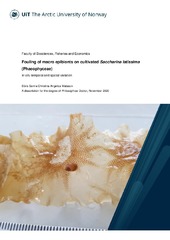Abstract
The motivation for macroalgal cultivation is to meet the global demand for food, energy and biomaterials for a rapidly growing human population in the context of the challenges of limited terrestrial food resources. Over the last 20 years the interest in seaweed cultivation has increased in European countries, and the kelp Saccharina latissima is one of the best-suited species for cultivation in North Atlantic waters. Epibiosis on cultivated seaweed in mid and high latitudes usually occurs from spring to summer, forcing the farmers to harvest the seaweed biomass before it reaches its potential maximum and higher carbohydrate content. Therefore, epibiosis is considered one of the main challenges in industrial seaweed farming. There has been a lack of knowledge about timing and species fouling cultivated S. latissima under different environmental conditions, including different latitudes, seasons and depths, as well as sporophyte age and nutritional history. This topic was investigated through three in situ studies, one with a large latitudinal range covering eleven degrees in latitude, one smaller-scale study within a geographical region characterized by differing environmental characteristics, and one with different outplanting dates resulting in various sporophyte ages within the same location at a given calendar date. The papers that this thesis is built upon show that there is spatial variability in phenology, degree and density of epibiosis on multiple scales on cultivated S. latissima. The present study has increased our knowledge about one of the bottlenecks for seaweed cultivation; epibiosis. Furthermore, this new fundamental understanding of timing and species diversity of epibiosis on cultivated S. latissima contributes to an overall understanding of the fouling issue along the Norwegian coast, enabling a broader view with important implications for the seaweed industry.
Has part(s)
Paper I: Matsson, S., Fieler, R. & Christie, H. (2019). Variation in biomass and biofouling of kelp, Saccharina latissima, cultivated in the Arctic, Norway. Journal of Aquaculture, 506, 445-452. Also available at https://doi.org/10.1016/j.aquaculture.2019.03.068.
Paper II: Forbord, S., Matsson, S., Brodahl, G.E., Bluhm, B.A., Broch, O.J., Handå, A., … Olsen, Y. (2020). Latitudinal, seasonal and depth-dependent variation in growth, chemical composition and biofouling of cultivated Saccharina latissima (Phaeophyceae) along the Norwegian coast. Journal of Applied Phycology, 32, 2215-2232. Also available in Munin at https://hdl.handle.net/10037/17221.
Paper III: Matsson, S., Metaxas, A., Forbord, S., Kristiansen, S., Handå, A. & Bluhm, B.A. Effects of outplanting time on growth, shedding and quality of Saccharina latissima (Phaeophyceae). (Submitted manuscript).


 English
English norsk
norsk
